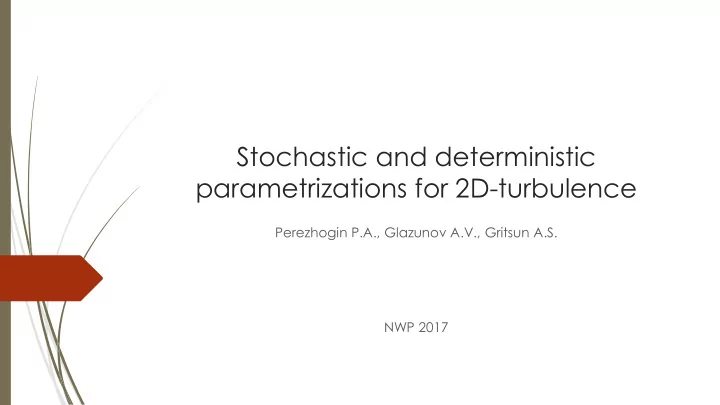

Stochastic and deterministic parametrizations for 2D-turbulence Perezhogin P.A., Glazunov A.V., Gritsun A.S. NWP 2017
Model equations Incompressible fluid on domain 0,2𝜌 × [0,2𝜌) with periodic b.c. Biharmonic damping −𝜈∆ 2 𝜕 Raleigh friction −𝛽𝜕 Stochastic forcing 𝑔 of fixed spatial scale with wavenumber 𝑙 𝑔 = 90 𝜖𝜕 𝜖𝑢 + 𝐾 𝜔, 𝜕 = −𝜈∆ 2 𝜕 − 𝛽𝜕 + 𝑔 ∆𝜔 = 𝜕 where 𝜔 – stream function, 𝜕 – vorticity
Numerical schemes E , skew-symmetric energy-conserving scheme • 𝒗 ⋅ 𝛼 𝑣 𝑗 ℎ = 1 𝑦 𝑘 + 1 𝑦 𝑘 𝑦 𝑗 𝑦 𝑗 𝜀 𝑦 𝑘 𝑣 𝑗 2 𝜀 𝑦 𝑘 𝑣 𝑘 𝑣 𝑗 2 𝑣 𝑘 INMCM , one of Arakawa schemes (Arakawa, 1977) • 𝒗 ⋅ 𝛼 𝑣 𝑗 ℎ = 2 𝑦 𝑘 + 1 ′ 𝑦 𝑘 𝑦 𝑗 𝜀 𝑦 𝑘 𝑣 𝑗 ′ 𝜀 𝑦 𝑘 3 𝑣 𝑘 3 𝑣 𝑘 ′ 𝑣 𝑗 Z , skew-symmetric enstrophy-conserving scheme (Arakawa, 1966) • CCS , finite volume Semi-Lagrangian scheme (Nair, 2002) •
Theory KLB(Kraichnan-Leith-Batchelor) Enstrophy ( 𝑎 = 1 2 𝜕 2 𝑒𝑦 ) moves to small scales Energy ( 𝐹 = 1 2 𝑣 2 𝑒𝑦 ) moves to large scales
Summary of previous work a) large scale forcing b) small scale forcing Importance of numerical schemes properties depends on resolution All coarse models fail in the case of small scale forcing
A priori analysis of subgrid forces Dynamics of coarse model is represented by filtered equations (spectral filtration denoted by overline): 𝜖 𝜕 𝜖𝑢 + 𝐾 ℎ 𝜔, 𝜕 = ⋯ + 𝜏 where 𝜏 – subgrid forces accounting for unresolved scales and numerical approximation 𝐾 ℎ ∗,∗ : 𝜏 = 𝐾 ℎ 𝜔, 𝜕 − 𝐾 𝜔, 𝜕 We run high resolution model 2160 × 2160 and gather statistics of subgrid forces for coarse models 360 × 360. Forcing scale is 4 mesh steps of coarse model ( 𝑙 𝑔 = 90, 𝑙 𝑛𝑏𝑦 = 180 ).
Spectral properties of subgrid forces rhs spectrum of advection in large scales is well represented by all coarse models • subgrid energy generation is comparable with forcing power and injects energy into the • large scales ( backscatter ) On short time intervals coarse models reproduce large-scale variability well. However during long time integration the absence of backscatter parametrization leads to the slow decay of large scale flows , and inverse energy cascade eventually breaks.
Backscatter parametrizations - 1 stochastic Ornstein-Uhlenbeck stochastic process in Fourier space (Berner, 2009). Decorrelation time and energy generation of subgrid forces are simulated by adjusting constants 𝛾 𝑙 and 𝛿 𝑙 . 𝜖𝜕 𝑙 𝜖𝑢 = ⋯ + 𝑡 𝑙 𝜖𝑡 𝑙 𝜖𝑢 = −𝛾 𝑙 𝑡 𝑙 + 𝛿 𝑙 𝜁 𝑙 𝑢 where 𝜁 𝑙 𝑢 − white noise with unit variance
Backscatter parametrizations - 2 eddy viscosity Linear model in Fourier space (Kraichnan 1976). Energy generation of subgrid forces is simulated by adjusting negative coefficient 𝜉 𝑙 . 𝜖𝜕 𝑙 𝜖𝑢 = ⋯ − 𝜉 𝑙 𝑙 2 𝜕 𝑙 , 𝜉 𝑙 < 0
A priori analysis of scale similarity model 𝜖𝑚 𝑘 𝜖𝜕 𝜖𝑢 = ⋯ + 𝑑 𝑡𝑗𝑛 𝜖𝑦 𝑘 𝑚 𝑘 = 𝑣 𝑘 𝜕 − 𝑣 𝑘 𝜕 Here (⋅) – test filter of width twice the mesh step, – additional spectral (⋅) filter that remove scales smaller then forcing scale. Scale similarity model reproduce shape of energy backscatter spectral distribution
Backscatter parametrizations - 3 stochastic+similarity Combined model incorporating stochastic and deterministic parts. Constants 𝑑 𝑡𝑢𝑝𝑑ℎ and 𝑑 𝑡𝑗𝑛 are adjusted in series of preliminary experiments with coarse model and chosen to fully compensate energy loss due to viscosity and scheme dissipation. Also, distribution of energy generation between stochastic and deterministic parts implemented in such a way as to get best results in large and middle scales at the same time. 𝜖𝜕 𝜖𝑚 𝑘 𝜖𝑢 = ⋯ + 𝑑 𝑡𝑢𝑝𝑑ℎ 𝑡 + 𝑑 𝑡𝑗𝑛 𝜖𝑦 𝑘 𝑚 𝑘 = 𝑣 𝑘 𝜕 − 𝑣 𝑘 𝜕 Here (⋅) – test filter of width twice the mesh step, (⋅) – additional spectral filter that remove scales smaller then forcing scale.
Experiments with coarse models - 1 Stochastic and eddy viscosity models effectively restore large scales Scale-similarity model restores middle scales (not shown) Combined model gives the best result: full inertial range of energy cascade was restored Fig. 2. Energy spectrum for different schemes (E, INMCM, Z, CCS).
Experiments with coarse models - 2 Large scale flows emerged Fig. 3. Stream function patterns for scheme E.
Experiments with coarse models - 3 Fig. 4. Autocorrelation functions of Fourier coefficients for 𝑙 = 30, scheme E. Autocorrelation functions of solution and advection rhs were restored
Experiments with coarse models - 4 Time averaged response to the small constant perturbation ( sensitivity ) has true extreme values for combined model (shown results is for scheme E)
Experiments with coarse models -5 Error of time averaged response reduces for 5-7 times in ∙ ∞ norm and for 3-4 times in ∙ 2 norm
Conclusions Parametrizations reproduce inverse energy cascade (energy spectrum, • stream function patterns, autocorrelation functions) These improvements in dynamics are due to restoration of internal • variability (parametrizations are small in norm compared to rhs) Stochastic and eddy viscosity parametrizations give almost the same results • however average response for eddy viscosity model is quite worse. Also it could be unstable (scheme Z). Combined model (stochastic+similarity) gives the best results and • demonstrates restoration of energy spectrum in middle and large scales at the same time. Also it has the best sensitivity among all the investigated parametrizations.
Recommend
More recommend